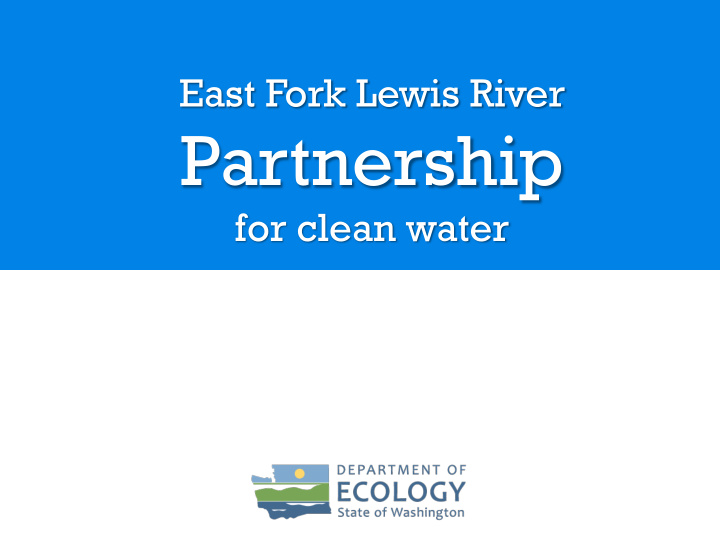



East Fork Lewis River Partnership for clean water
Welcome! Devan Rostorfer, TMDL Lead Shawn Ultican, Nonpoint Source Inspector Jen Riedmayer, Nonpoint Source Inspector Sheelagh McCarthy, Environmental Assessment Program Kessina Lee, Water Quality Program
Thank You! City of La Center
Agenda 1. Welcome and Introductions 2. East Fork Lewis River Source Assessment Report 3. Projects in the East Fork Lewis River Facilitated Discussion – Getting to Clean Water 4. 5. Break 6. Report Out & Next Steps 7. Optional Lunch and Tours
East Fork Lewis River Watershed • Clark and Skamania Counties • 212 square miles • Variety of Land Uses • Multiple Jurisdictions and Permits • Significant Public Access
The East Fork Lewis River is a Valuable Natural Resource Social Economic Environmental
East Fork Lewis River • Recreational Use and Enjoyment • Anglers • Kayakers • Swimmers • Hikers • Campers • Birdwatchers • Picnickers • Stormwater, Wastewater, Drinking Water • Agriculture
Water Quality Standards & Beneficial Uses • Recreation Uses – Bacteria Waterbody Recreation Bacteria Criteria Reach Uses EF Lewis Primary Geometric Mean: River from Contact 100 cfu/100 ml; mouth to Moulton falls 10% samples not to exceed 200 cfu/100 ml EF Lewis Extraordinary Geometric Mean: River from Primary 50 cfu/100 ml; Moulton Falls Contact to headwaters 10% samples not to exceed 100 cfu/100 ml • Water Quality for Public Health Bacteria increases risks to people swimming, wading, or fishing.
Water Quality Standards & Beneficial Uses • Aquatic Life Uses – Temperature Waterbody Reach Aquatic Life Uses Temperature Standard Highest 7- DADMax 16.0 ° C (60.8 ° F) EF Lewis River Core Summer Habitat • Water Quality for Environmental Health - High water temperatures create poor conditions for fish and wildlife. •
Impairments
What is a Water Cleanup Plan? • Watersheds with non-point sources - TMDL Alternative • Non-regulatory • Voluntary • Implementation based • TMDL Required for Polluted Waters on 303(d) list
East Fork Lewis River TMDL Alternative 9 Element Watershed Plan • Build Partnerships 1. Identify causes and sources 2. Estimate load reductions 3. Describe management measures and critical areas 4. Estimate technical and financial assistance 5. Develop education component 6. Develop a project schedule 7. Establish measurable milestones 8. Identify indicators to measure progress 9. Develop a monitoring plan
Goals 1. Develop project list to address bacteria and temperature issues by Summer 2019 2. Meet water quality standards (WQS) and support all beneficial uses in watershed - in the absence of a traditional TMDL 3. Solidify watershed eligibility for 319 funding 4. Strengthen partnerships 5. Support existing projects and plans
East Fork Lewis River Partnership
Partnership Principles SOPs for Success • Relationship Building • Mutual Respect • Focus on Future Solutions • Keep Water Quality Central
30 Second Introductions • Who are you? Name, organization you’re representing • What do you do? Involvement in the East Fork Lewis River?
Getting to Clean Water in the East Fork Lewis River
Recommendations Reduce Fecal Coliform Bacteria and Improve Water Quality • Nonpoint source – • Implement agricultural BMPs • Continue education and outreach work • Infrastructure – • Stormwater - Conduct investigative stream walks to identify and sample unknown or unmapped outfalls, pipes, or culverts. • Wastewater - Fix failing Onsite Septic Systems (OSS). • Priority Areas – Brezee and McCormick Creeks Summarized from: McCarthy, 2018. East Fork Lewis River Watershed Bacteria and Temperature Source Assessment Report. Washington State Department of Ecology, Olympia, WA. Publication No. 18-03-019
Recommendations - Temperature Restore Riparian and Stream Habitat • Natural Resources – Increase, enhance, protect, and restore….. • Wetlands • Native Planting • Streambanks • Channel Complexity • Riparian Habitats • Natural Flood Plains • Cold Water Refugia • Instream Habitat Quality • Trees Planting • Other - Consider effects of current and future water withdrawals • Priority Area - Large shade deficits in the middle watershed Summarized from: McCarthy, 2018. East Fork Lewis River Watershed Bacteria and Temperature Source Assessment Report. Washington State Department of Ecology, Olympia, WA. Publication No. 18-03-019
Facilitated Discussion With partnership and funding needs in mind, in the East Fork Lewis River….. • Past - What are some of the historical challenges or barriers related to achieving clean water in the watershed? • Present - What are some of the ongoing challenges, priorities, projects, planning, or implementation efforts in the watershed? • Future - What are some of the next steps, future programs, and projects needed to achieve clean water? • Other - Is there anyone that should be engaged in the partnership that isn’t currently at this meeting?
Report Out & Next Steps Bacteria and Temperature Workgroups
Bacteria and Temperature Workgroups • Fall 2018 – Sign up now! • Workgroup meetings • Impairment specific workgroups • Focus on projects, planning, and programmatic solutions • Draft implementation actions and strategies • Discuss partnership and funding needs
East Fork Lewis River Website Stay up to date! Website: https://ecology.wa.gov/Water-Shorelines/Water- quality/Water-improvement/Total-Maximum-Daily-Load- process/Directory-of-improvement-projects/East-Fork-Lewis- River
Attend a grant workshop! • WQC Applicant Workshop in Lacey • Date: August 22, 2018 • Time: 9:00 a.m. – 1:00 p.m. • Location: St . Martin’s University
Thank you! Optional Lunch 11:30 a.m. – 12:30 p.m. at Sternwheeler Park Optional Tour 12:00-12:20 p.m. La Center Bottoms with Clark County (Meet at amphitheater in Sternwheeler Park) Optional Tour 12:30-1:30 p.m. La Center Wastewater Treatment Plant (Meet at amphitheater in Sternwheeler Park)
Recommend
More recommend